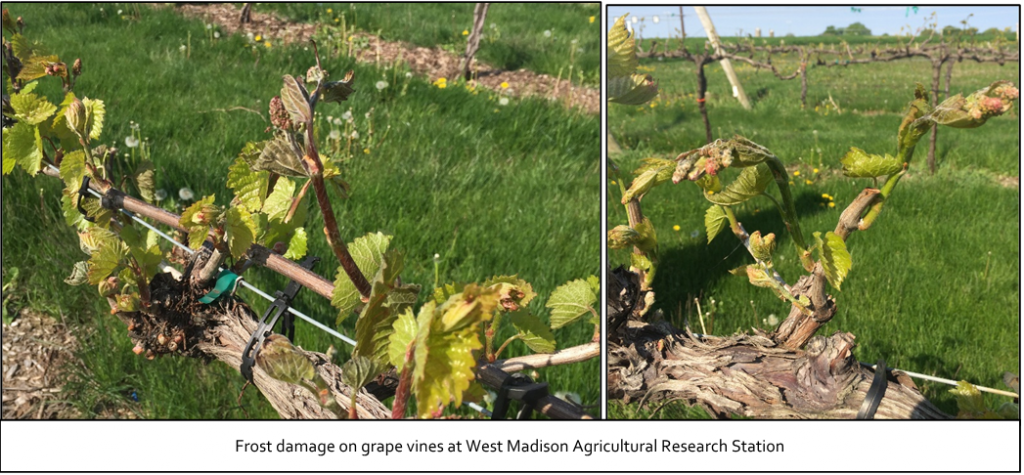How Could This Warm Weather Affect Fruit Crops?
The frost of May 14-15 was a particularly late frost and many of you are probably wondering what to do now. Here are some recommendations based on the extent of the damage you might have:
1) No crop: If the extent of the damage is so that you have no crop this season then the priority will be to maintain healthy growth for next year by working on shoot positioning to have high quality canes to become spurs. Because there is no crop to keep the vines in balance, you should be careful with overly vigorous shoots that will become “bull” canes. Keep as many shoots as possible so that the vigorous growth will dissipate across all the shoots, and do not use any nitrogen fertilizer. However, make sure to keep up with shoot positioning so that the canopy is open and shoots are well expose to light. Shaded shoots in a dense canopy are less cold hardy and you will have higher disease incidence.
If there is no crop to protect, then your fungicide program can be significantly reduced. Vines with no crop generally can withstand more foliar disease. However, if downy mildew gets started early in the season, it will need to be managed. This disease can cause premature defoliation, which in turn leads to reduced winter hardiness. The phosphorous acid fungicides, captan, mancozeb, and copper-based fungicides are all effective on downy mildew and in some cases, relatively inexpensive (see the 2016 Midwest Fruit Pest Management Guide for options). Without a crop, the 66-day preharvest interval for mancozeb is irrelevant, meaning you can apply it later than you normally would.
2) Severe damage to primary shoots, crop on secondary shoots: This is probably the most complicated scenario in terms of vineyard management. Secondary shoots will be delayed by a couple of weeks in comparison to primary shoots, and so will be veraison and ripening. This means that within one vine you will have clusters at different stages of maturity. Dr. Sabbatini at Michigan State University tracked the development of cluster from primary and secondary shoots of Marquette after a spring frost in 2012. He reported that clusters on secondary shoots were delayed by about 3 weeks compared to cluster on primary shoots. However due to the early spring and warm temperatures during the 2012 season, clusters on secondary shoots did reach maturity at the end of the season (brix ~24; TA~7.6). This spring was not as early as 2012, so you should take in consideration that fruit from secondary shoots will be delayed by 3 to 4 weeks and they might not reach maturity by the end of the growing season, and shoots might not harden off to survive winter.
Should you keep the crop from secondary shoots? On the one hand having some fruit will help reduce the vigor of vines and therefore prevent bull canes. On the other hand, 3 to 4 weeks delayed may be too late to harvest the fruit, which could also affect winter hardiness of the canes, potentially risking next year’s crops as well.
What are the disease management issues with this scenario? The greatest challenge will be dealing with the presence of flowers and young fruit over a period of several weeks. The most important time to protect fruit is just prior to, during, and up to 4 weeks after bloom. This is when berries are most susceptible to downy mildew, powdery mildew, and black rot. Normally this period is confined to about 6 weeks. However, with secondary shoots blooming later than primary shoots, the need to protect berries will be prolonged by about 2 to 3 weeks. This translates into an additional spray or two.
A second issue is that dying primary shoots are susceptible to Botrytis. While we normally think of Botrytis as a threat to ripening fruit clusters (Botrytis bunch rot or gray mold), it is also an opportunistic pathogen of dying leaves/shoots. If decaying primary shoots are present when the surviving shoots are in bloom, and the weather is cool and wet, then flowers could become infected with Botrytis. When Botrytis infects flowers, it generally remains dormant until berries start to ripen, and then it causes rot. Therefore, if decaying tissues are visible in the canopy during bloom, it would be prudent to apply a fungicide with activity against Botrytis (see the 2016 Midwest Fruit Pest Management Guide for options). If your vineyard is relatively small and/or you are growing with minimal fungicide input, you might attempt to remove the dying primary shoots to prevent Botrytis build up. However, this is simply not practical in most vineyards, and with a good spray program to protect flowers and fruit, it’s probably not necessary.
3) Reduced crop on primary shoots: If you experienced a modest frost and have a partial crop on primary shoots, you might want to remove the fruit on secondary shoots. This will make vineyard management much easier; you will have all clusters ripening at the same stage and they will reach maturity at the end of the growing season. In this scenario, disease management should proceed as normal, where the fungicides are focused just prior to, during, and up to 4 weeks after bloom. Thereafter, spraying should be based on scouting and weather conditions.


